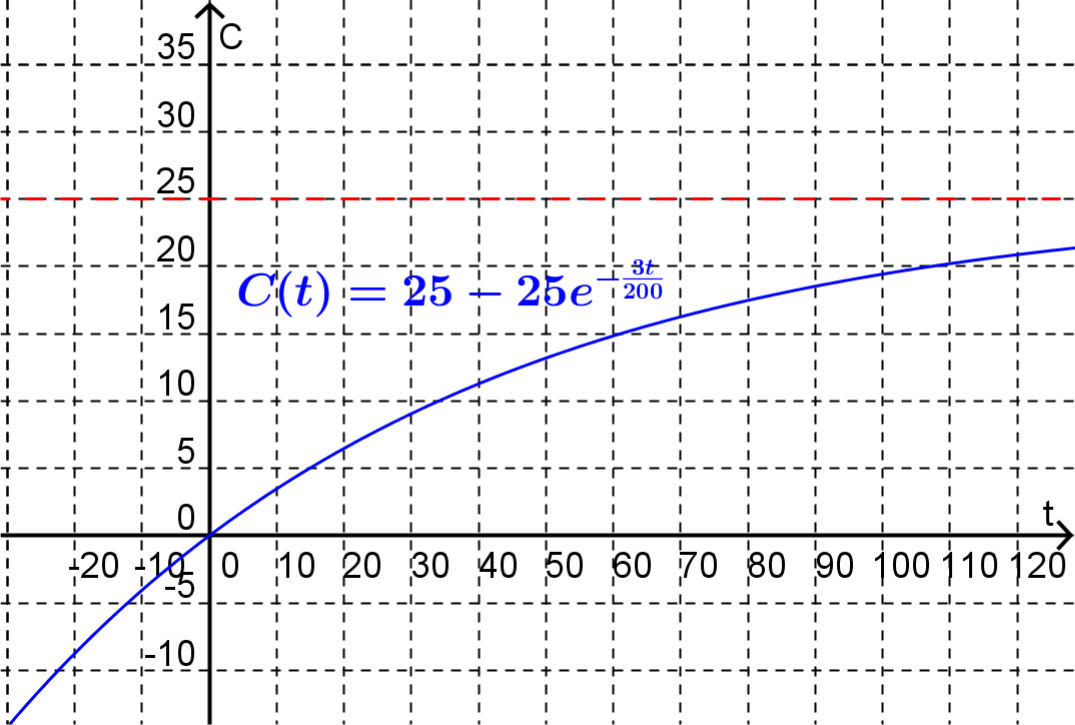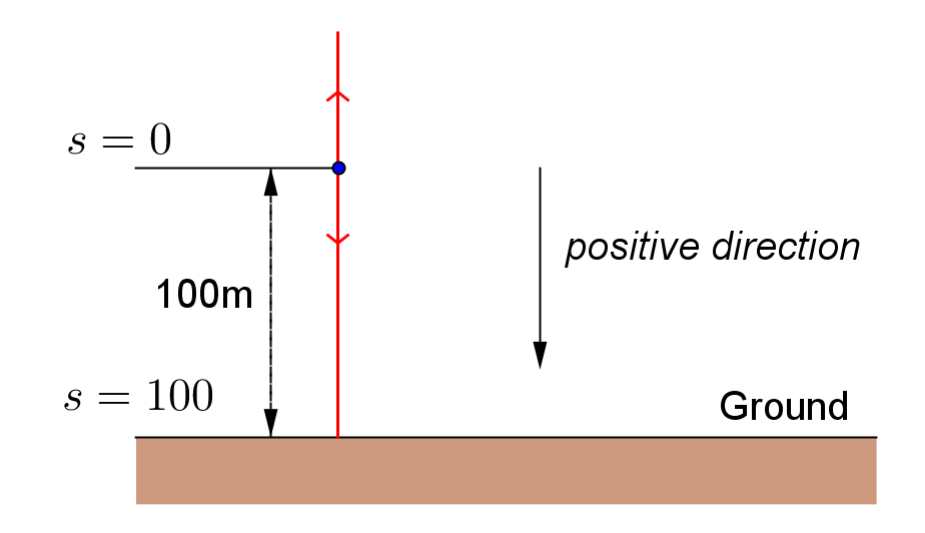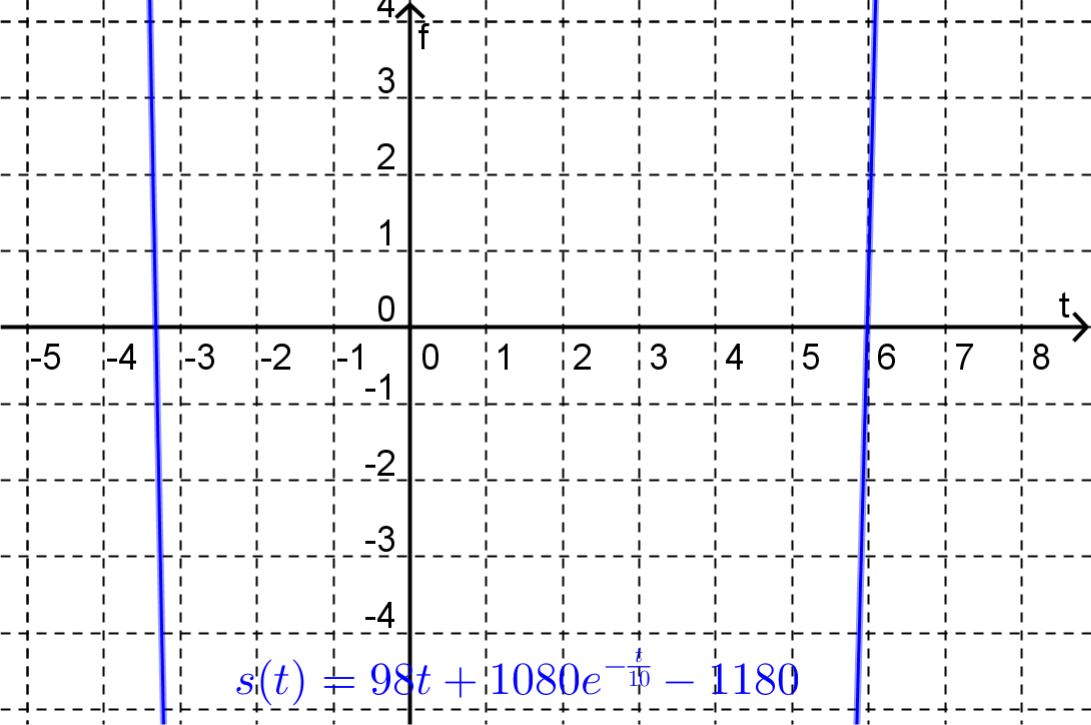Section 11.3 Some Simple Applications of First Order Linear DEs
Example 11.3.1. Radioactive Decay.
The radioactive isotope thorium \(234\) disintegrates at a rate proportional to the amount present. If \(100\) milligrams of this isotope is reduced to \(82.04\) milligrams in one week, find:
An expression for the amount present at any time.
The time taken for the amount of isotope to decay to one half of its original value.
\(\displaystyle Q(t) = 100 e^{-0.0283t}\)
\(\displaystyle t \approx 24.5 \, \text{ days}\)
Let \(Q(t)\) be the amount (in milligrams) of thorium \(234\) present at time \(t\) (in days). Then
\begin{equation*} \dfrac{dQ}{dt} = -kQ\text{,} \end{equation*}where \(k\) is a positive constant and\begin{equation*} Q(0) = 100, Q(7) = 82.04\text{.} \end{equation*}The DE is separable but if we write it as\begin{equation*} \dfrac{dQ}{dt} + kQ = 0\text{,} \end{equation*}then we see that it is also linear. The integrating factor is\begin{equation*} I(t) = e^{\int k \, dt} = e^{kt}\text{.} \end{equation*}Multiplying both sides by this integrating factor gives\begin{equation*} \dfrac{d}{dt} \left( e^{kt} Q \right) = 0\text{,} \end{equation*}and hence the general solution is\begin{equation*} Q(t) = Ae^{-kt}\text{.} \end{equation*}Using \(Q(0) = 100\) gives \(A = 100\) and from \(Q(7) = 82.04\) we obtain\begin{equation*} 82.04 = 100 e^{7k} \end{equation*}from which\begin{equation*} k = \dfrac{\ln (0.8204)}{7} = 0.0283 \: (\text{ to 4 dp})\text{.} \end{equation*}Thus\begin{equation*} Q(t) = 100 e^{-0.0283t}\text{.} \end{equation*}The time when the amount of isotope has decayed to \(50\) milligrams is the value of \(t\) that satifies
\begin{equation*} 50 = 100 e^{-kt}\text{,} \end{equation*}which is\begin{equation*} t = \dfrac{\ln(0.5)}{-k} = \dfrac{\ln(2)}{k} \approx 24.5 \, \text{ days}\text{.} \end{equation*}
Example 11.3.2. Mixing Tank.
A \(200\)L tank contains pure water. At time \(t=0\) brackish water (i.e. water containing salt) begins to flow into the tank at a rate of \(3\)L/min and mixed water flows out at the same rate. Assuming that the concentration of salt in the inflowing water is \(25\)g/L determine the concentration of salt in the water in the tank as a function of time.
\(C(t) = 25 - 25 \exp \left(- \dfrac{3}{200}t \right)\)
Let \(C(t)\) be the concentration (in g/L) of the salt in the water in the tank at time \(t\) minutes after the mixing began and let \(A(t)\) be the amount (in grams) of salt in the tank at time \(t\text{.}\) Then \(C(0) = 0\) and \(A(0) = 0\text{.}\)
Now, salt is coming into the tank at the rate
and it is leaving the tank at the rate
Thus \(A(t)\) will satisfy the DE
Using \(A(t) = 200 C(t)\) this becomes
which can be written as
This is a first order linear DE and hence can be solved by multiplying the equation by the integrating factor
In doing this we obtain
and hence
Thus the general solution is
Using \(C(0) = 0\) gives \(K = -25\) and so the required concentration function is
Figure 11.3.3 shows a graph of this function. It can be seen that as \(t \to \infty\text{,}\) \(C \to 25\text{.}\) Thus as time goes by the concentration of salt in the tank water approaches the concentration of the salt in the brackish water coming into the tank.

Example 11.3.4. Motion in One Dimension.
A ball of mass \(50\)kg is shot from a cannon \(100\)meters above the ground straight up with an initial velocity of \(10\)m/s. Assuming that the air resistance is given by \(5v\text{,}\) where \(v\) is the velocity, determine the velocity of the ball when it hits the ground.
Note: This is a very simple model for the air resistance chosen mostly to simplify the resultant equations
\(v(5.98147) = 38.6 \, \text{m/s} \: (\text{to 1dp})\)
Let \(v(t)\) be the velocity of the ball at time \(t\) seconds after it was fired from the cannon and let the downward direction be the positive direction as shown in Figure 11.3.5.

The motion of the ball will be governed by Newton's second law of motion which says
where \(F\) is the net force acting on the ball, \(m\) is its mass and \(a\) is its acceleration. Once the ball leaves the cannon the forces acting on the ball are gravity, which we will denote by \(F_G\) and air resistance, denoted by \(F_R\text{.}\) Now with the positive direction as shown in Figure 11.3.5,
where \(g\) is the acceleration due to gravity. In the initial phase where the ball is going up the air resistance will be acting against the motion, (i.e. in the positive direction). Thus, since the velocity \(v\) is negative
In the second phase where the ball is falling the air resistance will again be acting against the motion (i.e. in the negative direction). In this phase the velocity is positive and so once again
Thus the net force acting on the ball is
Since
Newton's second law gives
or
with
This is a first order linear DE in \(v(t)\text{.}\) To solve, multiply both sides of the DE by the integrating factor
to get
Integrating both sides gives
and hence, using \(m=50\text{,}\) \(g=9.8\) and \(v(0) = -10\text{,}\)
Thus we have determined the velocity function for the ball. To use this to determine the speed of the ball when it hits the ground we must first determine the time at which the ball hits the ground. To do this we will need the displacement function which we can obtain by integrating the velocity function. So, letting \(s(t)\) be the displacement of the ball at time \(t\text{,}\) we have
Using \(s(0)=0\) gives \(K=-108\) and so the displacement function is
Now \(s(t) = 100\) when
Figure 11.3.6 shows a plot of the function
and as can be seen there is only one positive solution. Solving this equation numerically (using Newton’s method for example), shows this solution to be

Thus the velocity of the ball when it hits the ground will be
Exercises Example Tasks
1.
A population of insects in a region will grow at a rate that is proportional to their current population. In the absence of any outside factors the population will triple in two weeks time. On any given day there is a net migration into the area of \(15\) insects and \(16\) are eaten by the local bird population and \(7\) die of natural causes. If there are initially \(100\) insects in the area will the population survive? If not, when do they die out?
2.
A tank with a capacity of \(500\)L originally contains \(200\)L of water with \(10\)kg of salt in the solution. Water containing \(0.1\)kg of salt per litre is entering the tank at a rate of \(3\)L/min and the mixture is allowed to flow out of the tank at a rate of \(2\)L/min. Find the concentration of salt in the water in the tank at any time before the tank overflows.